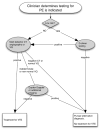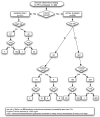Prospective diagnostic accuracy assessment of the HemosIL HS D-dimer to exclude pulmonary embolism in emergency department patients
- PMID: 19515402
- PMCID: PMC2826532
- DOI: 10.1016/j.thromres.2009.04.009
Prospective diagnostic accuracy assessment of the HemosIL HS D-dimer to exclude pulmonary embolism in emergency department patients
Abstract
Introduction: Chest pain and shortness of breath are among the most common symptoms requiring immediate evaluation. Testing for pulmonary embolism (PE) has become easier and widespread due to D-dimer blood tests. Safe use of these tests is only possible if sensitivity is high and they are used in non-high probability patients. We evaluated diagnostic performance of the HemosIL HS D-dimer, which despite FDA approval in 2005, has been minimally reported in prospective standard clinical care.
Materials and methods: We used a prospective observational study design to follow patients in a single center with the HemosIL HS ordered for symptoms of possible PE with positive test result if >243 ng/ml. The outcome was PE or deep venous thrombosis (DVT) at the time of presentation or subsequent 45 days determined by structured evaluation of imaging tests, phone, or medical record follow-up in all patients.
Results: 529 patients received a D-dimer and 4.7% were ultimately diagnosed with PE or DVT. The sensitivity of the HemosIL HS was 96.0% (95% CI; 79.6 to 99.9%) specificity was 65.7% (95% CI; 61.4 to 69.8%) and likelihood ratio negative was 0.06 (95% CI; 0.01 to 0.42). The probability of PE in patients with a negative D-dimer was 1/332 or 0.3% (95% CI; 0.01% to 1.67%). The receiver operator curve had an area under the curve of 0.87 and supported the current cut-point as optimal.
Conclusions: The HemosIL HS D-dimer had high sensitivity, very low negative post-test probability and is useful in excluding PE in the acute care setting.
Copyright 2009 Elsevier Ltd. All rights reserved.
Conflict of interest statement
Figures



References
-
- McCaig LF, Nawar EW. National hospital ambulatory medical care survey: 2004 emergency department summary. Adv data. 2006;372:1–29. - PubMed
-
- Kline JA, Webb WB, Jones AE, Hernandez-Nino J. Impact of a rapid rule-out protocol for pulmonary embolism on the rate of screening, missed cases, and pulmonary vascular imaging in an urban US emergency department. Ann Emerg Med. 2004;44:490–502. - PubMed
-
- Kabrhel C, Matts C, McNamara M, Katz J, Ptak T. A highly sensitive ELISA D-dimer increases testing but not diagnosis of pulmonary embolism. Acad Emerg Med. 2006;13:519–524. - PubMed
-
- Stein PD, Hull RD, Patel KC, Olson RE, Ghali WA, Brant R, Biel RK, Bharadia V, Kalra NK. D-dimer for the exclusion of acute venous thrombosis and pulmonary embolism: a systematic review. Ann Intern Med. 2004;140:589–602. - PubMed
-
- Wells PS. Integrated strategies for the diagnosis of venous thromboembolism. J Thromb Hemost. 2007;5(Supplement 1):41–50. - PubMed
Publication types
MeSH terms
Substances
Grants and funding
LinkOut - more resources
Full Text Sources
Medical

